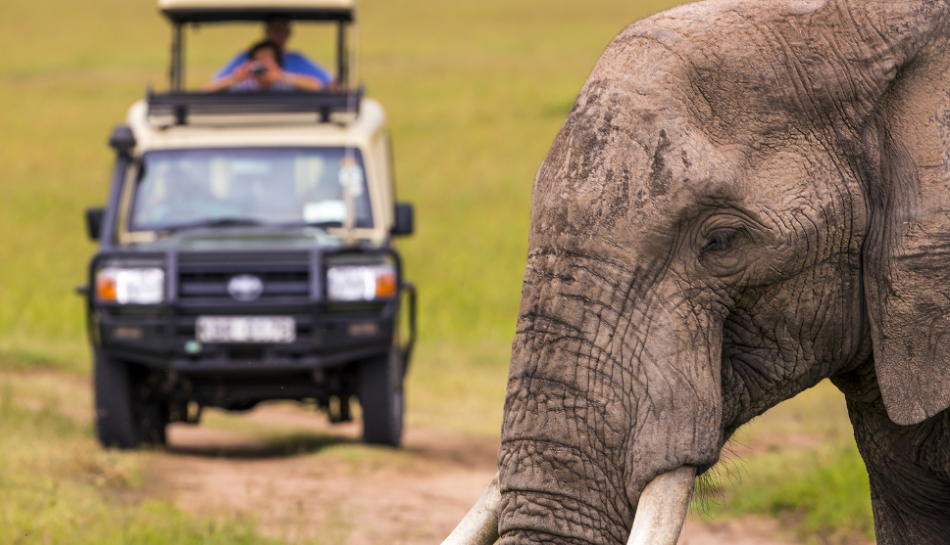The Ultimate Guide to Planning Your Dream Safari in Kenya
Let us walk you through everything you need to know to plan your dream safari in Kenya. Buckle up and get ready for a journey that promises to ignite your wanderlust and deliver memories that will last a lifetime.
Choosing the Best Time to Visit Kenya
Kenya’s diverse climate means that there’s never a bad time to visit, but your timing can greatly influence your safari experience. The country has two main seasons: the dry season and the rainy season.
Dry Season (June to October): This is the prime safari season, with clear skies, lower humidity, and animals gathering around water sources, making wildlife spotting easier. If you're aiming to witness the Great Migration, July to September is the peak period when millions of wildebeest, zebras, and gazelles cross the Mara River in search of greener pastures.
Rainy Season (November to May): The rains bring lush green landscapes and fewer tourists. While you might encounter some showers, the scenery is breathtaking, and the wildlife is still active. The short rains (November to December) and long rains (March to May) each offer unique experiences, including vibrant flora and fewer crowds.
Deciding on the best time depends on your interests. If you're keen on witnessing the Great Migration or experiencing classic dry season game viewing, aim for the dry season. For a more tranquil experience with lush landscapes, consider the rainy season.
Selecting the Right Safari Destinations
Kenya boasts a variety of safari destinations, each offering unique landscapes and wildlife experiences. Here's an overviews of the diverse attractions that make Kenya a top tourist destination, offering everything from iconic safaris and mountain trekking to rich cultural experiences and stunning beaches
-
Masai Mara National Reserve: Known for its incredible wildlife and the Great Migration, the Masai Mara is a top choice for iconic safari experiences. Its vast savannahs are home to the Big Five and numerous other species, including cheetahs and hyenas. Stay in luxury lodges or intimate tented camps for an immersive experience.
-
Amboseli National Park: Famous for its large elephant herds and stunning views of Mount Kilimanjaro, Amboseli offers excellent wildlife viewing and breathtaking landscapes. The park’s swamps and lakes attract a wide range of animals and birds, making it a paradise for photographers.
-
Samburu National Reserve: Located in northern Kenya, Samburu is known for its unique wildlife species, including the reticulated giraffe, Somali ostrich, and Grevy’s zebra. Its arid landscapes and vibrant cultural interactions with the Samburu people add to its charm.
-
Lake Nakuru National Park: A haven for birdwatchers, Lake Nakuru is renowned for its flamingo population and rhino sanctuary. The park’s diverse habitats, including woodlands and grasslands, provide a range of wildlife viewing opportunities.
-
Tsavo National Parks (Tsavo East and Tsavo West): Covering a vast area, Tsavo is one of Kenya’s largest and oldest parks. It offers diverse landscapes, from volcanic hills to savannahs, and is known for its large herds of elephants and the famous Man-Eaters of Tsavo.
-
Laikipia Plateau: This private ranching area is ideal for a more exclusive safari experience. It offers unique wildlife encounters and activities like walking safaris and horseback riding, providing a different perspective on the Kenyan bush.
-
Nairobi National Park: Located just outside the capital city, Nairobi National Park is unique for its proximity to a major urban center. It offers a variety of wildlife, including lions, rhinos, and giraffes, with the city skyline as a backdrop. It's an ideal destination for a quick safari experience.
-
Mount Kenya National Park: Home to Africa's second-highest peak, Mount Kenya offers challenging trekking and climbing opportunities. The park is also rich in biodiversity, with unique alpine vegetation and rare animal species like the Mount Kenya hyrax.
-
Diani Beach: A popular coastal destination, Diani Beach is known for its white sandy beaches, clear blue waters, and vibrant coral reefs. It offers a range of activities, including snorkeling, scuba diving, and kite surfing, along with luxury resorts and beachfront hotels.
-
Lamu Island: Part of the Lamu Archipelago, Lamu Island is a UNESCO World Heritage Site known for its well-preserved Swahili architecture and rich cultural heritage. The island is car-free, offering a peaceful retreat with a blend of history, culture, and beautiful beaches.
-
Hell's Gate National Park: Known for its dramatic landscapes, including towering cliffs, gorges, and geothermal features, Hell's Gate offers unique activities like rock climbing, hiking, and cycling. The park's wildlife includes buffalo, zebras, and numerous bird species.
-
Lake Turkana: Often called the "Jade Sea" due to its striking turquoise color, Lake Turkana is the world's largest desert lake. It's a remote destination known for its unique landscapes, prehistoric archaeological sites, and the traditional cultures of the Turkana people.
-
Aberdare National Park: Known for its cool climate and lush forests, Aberdare National Park offers a chance to see forest elephants, leopards, and the rare bongo antelope. The park features scenic waterfalls and provides a habitat for numerous bird species.
-
Meru National Park: Less visited than some other parks, Meru offers a sense of wilderness and tranquility. It is home to diverse wildlife, including elephants, lions, and rhinos, and boasts scenic landscapes ranging from rivers to savannahs.
-
Malindi and Watamu: These coastal towns are known for their beautiful beaches, coral reefs, and historical sites. The Watamu Marine National Park is a popular spot for snorkeling and diving, while Malindi offers cultural attractions like the Gede Ruins and Vasco da Gama Pillar.
-
Kisite-Mpunguti Marine National Park: Located near the southern border of Kenya, this marine park is a paradise for snorkelers and divers, known for its coral reefs and rich marine life, including dolphins, sea turtles, and various fish species.
-
Mount Elgon National Park: Straddling the Kenya-Uganda border, Mount Elgon is an extinct volcano with a unique landscape. The park offers hiking, caving, and wildlife viewing, with species like elephants and buffalo frequenting the region.
- Giraffe Centre: The Giraffe Centre offers a rare opportunity to get up close and personal with endangered Rothschild giraffes. You can feed these gentle giants and learn about their conservation. The center is also home to a variety of bird species and offers guided nature walks.
Choosing Your Safari Experience
Safaris can be tailored to your preferences, ranging from classic game drives to unique, immersive experiences. Here are some options to consider:
Game Drives: The most popular safari experience, game drives are conducted in specially designed 4x4 vehicles that allow for up-close wildlife viewing. Morning and evening drives are the best times to spot wildlife, with cooler temperatures and more active animals.
Walking Safaris: For a more intimate experience, consider a walking safari. Accompanied by a knowledgeable guide, you’ll explore the bush on foot, learning about tracks, plants, and smaller wildlife that you might miss on a vehicle safari.
Hot Air Balloon Safaris: Experience the landscape from above with a hot air balloon safari. This magical ride offers panoramic views of the savannah and wildlife below, followed by a champagne breakfast in the bush.
Night Safaris: Venture out after dark to see nocturnal wildlife and experience the bush’s nighttime sounds. Night safaris are available in some parks and provide a unique perspective on the safari experience.
Cultural Safaris: Combine wildlife viewing with cultural interactions by visiting local communities. Engage with the Maasai, Samburu, or other tribes to learn about their traditions, customs, and way of life.
Planning Your Safari Itinerary
A well-planned itinerary can make all the difference in your safari experience. Here’s a sample itinerary to get you started:
Day 1: Arrival in Nairobi
- Arrive at Jomo Kenyatta International Airport and transfer to your Nairobi accommodation. Take time to relax and perhaps explore the city or visit attractions like the David Sheldrick Wildlife Trust.
Day 2-4: Masai Mara National Reserve
- Fly or drive to the Masai Mara for a classic safari experience. Spend the next few days exploring the reserve with morning and evening game drives. Consider adding a hot air balloon ride for a unique perspective.
Day 5-6: Amboseli National Park
- Fly or drive to Amboseli National Park. Enjoy game drives with stunning views of Mount Kilimanjaro and the park’s diverse wildlife. Visit local Maasai villages for cultural insights.
Day 7-8: Lake Nakuru National Park
- Head to Lake Nakuru for birdwatching and rhino tracking. Explore the park’s diverse landscapes and enjoy relaxing by the lake.
Day 9-10: Tsavo National Parks
- Travel to Tsavo for a mix of game drives and exploration. Visit both Tsavo East and Tsavo West to experience the full range of landscapes and wildlife.
Day 11-12: Laikipia Plateau
- Conclude your safari with a stay in Laikipia. Engage in walking safaris or horseback riding and enjoy a more exclusive safari experience.
Day 13: Return to Nairobi
- Return to Nairobi for your departure. Reflect on your incredible safari adventure and perhaps squeeze in some last-minute shopping or sightseeing.
Choosing Accommodation: From Luxury Lodges to Tented Camps
Kenya offers a wide range of accommodations to suit every budget and preference. Here’s a look at what you can expect:
Luxury Lodges: Enjoy opulent comforts in lodges with stunning views, gourmet dining, and exceptional service. Options like Angama Mara, Ol Donyo Lodge, and Giraffe Manor offer unparalleled luxury and unforgettable experiences.
Tented Camps: For an immersive experience, stay in tented camps that blend luxury with a closer connection to nature. Camps like &Beyond Kichwa Tembo and Saruni Mara offer a blend of adventure and comfort.
Budget Options: If you’re traveling on a budget, Kenya has a range of affordable lodges and camps that provide basic amenities and excellent wildlife experiences. Options like public campsites and budget lodges offer great value.
Preparing for Your Safari: What to Pack and What to Expect
Packing smart is key to a successful safari. Here’s a list of essentials and tips for your adventure:
Clothing: Pack lightweight, breathable clothing in neutral colors (khaki, beige, olive) to blend in with the environment. Include a hat, sunglasses, and layers for varying temperatures. Don’t forget a rain jacket for unexpected showers.
Footwear: Comfortable walking shoes or boots are essential for game drives and walking safaris. Bring sandals or flip-flops for relaxing at your lodge or camp.
Health and Safety: Ensure you have appropriate vaccinations and malaria prophylaxis. Pack a basic first aid kit, sunscreen, insect repellent, and any personal medications.
Gear: A good quality camera with zoom lenses is a must for capturing wildlife. Bring binoculars for better viewing, and a travel adapter for charging your electronics.
Documents: Carry your passport, visa (if required), travel insurance, and any necessary permits for national parks or reserves.
Booking Your Safari: Tips and Considerations
Choosing the right tour operator and making bookings is a crucial part of planning your safari. Here’s what to keep in mind:
Research Operators: Look for reputable safari operators with positive reviews and strong customer support. Ensure they are knowledgeable about Kenya’s national parks and provide personalized service.
Book Early: Popular lodges and camps can book up quickly, especially during peak season. Secure your accommodations and activities well in advance to avoid disappointment.
Understand Inclusions: Verify what is included in your safari package. This typically covers accommodation, meals, park fees, and game drives, but check for any additional costs or optional extras.
Custom Itineraries: Many operators offer customizable itineraries. Work with them to tailor your safari experience to your interests and preferences, whether it’s focusing on wildlife, culture, or adventure.
Embracing the Safari Spirit: What to Expect and How to Prepare
A safari in Kenya is as much about the journey as it is about the destination. Embrace the adventure with an open mind and a spirit of curiosity. Be prepared for early mornings, thrilling wildlife encounters, and the occasional bumpy road. Keep your camera ready, be patient, and savor every moment.



